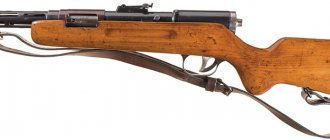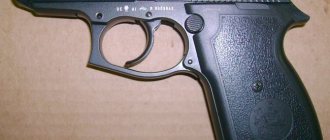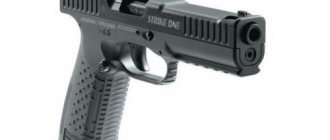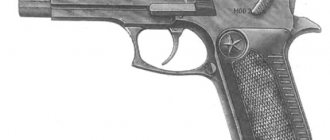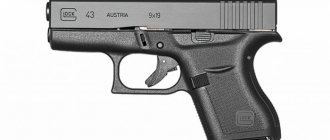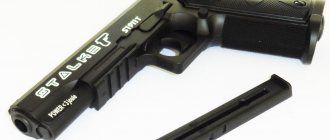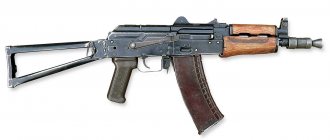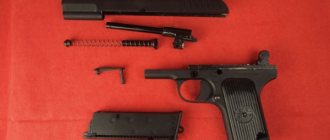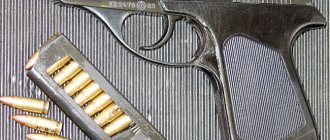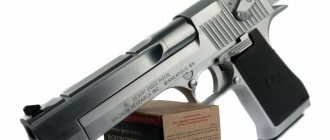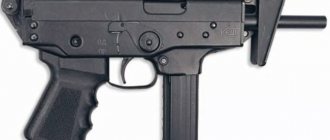Application Description
As developed by Gerard Henrotin – HLebooks.com
,
Bayard pistol 1908 explained
is a
Books & Reference
on the Android platform.
The current version of Android AP26 b – 2018
was released on
September 18, 2018
.
This app has over 23
downloads. You can check the details below.
Bayard 1908 Pistol Removal Field Extended Slide Removal - Extractor Removal - Fork Removal - Striker Removal - Extended Frame Removal (I) - Trigger Assembly Removal - Trigger Connector Removal - Resting Pin Removal - Automatic Safety Removal - Correct Positioning Automatic Spring Safety Switch - Advanced Frame Removal (II) - Dismantling and hammering the main spring - Dismantling the main spring retainer - Hammer tip reinstallation - Dismantling the sear - Dismantling the manual safety Advanced frame dismantling (III) - Dismantling the catch magazine - Possible dismantling of the spring safety index - Dismantling the recoil buffer components - Possible dismantling of the rear grip belt - Dismantling magazine - Cutaway view of the pistol - Parts legend Functioning of Bayard 1908 pocket pistol(s) - Reaming the cartridge - Lower edge of the breech face - Reducing the hammer on the slide - The barrel face pushes the cartridge from the magazine - Feeding the ramp - The cartridge groove under the draw claw - How the slide is held on frameFunctioning of the Bayard 1908 pocket pistol (II)- Functioning of the trigger mechanism- Connector and disconnector functioning- Blowback type recoil- Early stage of recoil- Full recoil and case ejection- Functioning of the Recoil bufferIn the safety of this Bayard 1908 pocket pistol- Explained the automatic safety- Explained the manual safety - Safety lever used as cocking indicator Markings on Bayard 1908 pocket pistol - Serial number - Belgian proof markings - German military proof markings - Markings associated with manufacturer - Markings associated with caliber Various models of Bayard 1908 pocket pistol - Early models with safety lever guiding ribs - Magazine of early type - Early models without safety lever guiding ribs - 1914 Pieper Catalog - Early buffer components - Attachment connector at the beginning of the trigger - Later after 1914 models - Features of the 6.35 model - Luxury models Headings of Pieper company and production (I) - Henri Pieper founder of the company - ETABLISSEMENTS PIEPER- FOREST ANCIENS ETABLISSEMENTS PIEPER- Commercial catalog 1914- Shotgun production- Shotgun body action and locking- Shotgun models with external hammers- Spare parts of hammer gunsPieper firm and production headings (II)- Hammerless shotgun models- Spare parts of Hammerless shotguns- semi-automatic carbines Model 1912 in .22 caliber - Semi-automatic carbine spare parts - Semi-automatic pistol in .22 caliber - Bergman Bayard semi-automatic pistol in 9mm caliber - Pieper Bayard Model 1923 - Inactive shotgun Since 2000, “HLebooks.com” has specialized in publishing downloadable technical textbooks on collectible firearms. we have more than 2000+ devices available for Samsung, Xiaomi, Huawei, OPPO, VIVO, Motorola, LG, Google, OnePlus, Sony, tablet... with so many options, you can easily choose the games or software that suits your device ,
Read more
Pistol (41 photos)
A pistol is a weapon for close-range combat. According to their purpose, pistols can be divided into three groups: military, sports and civilian firearms and traumatic weapons.
Military firearms are used by intelligence services for attack and defense. The pistol's light weight and very modest size compared to automatic weapons make it possible to freely open fire on a target from any position. Sports weapons are intended for shooting competitions and training shooting. Civilian weapons are designed to protect your life from attack.
Citizen with a pistol in a war zone
Woman putting a gun in her purse
Revolver for self-defense behind a man's back
Remington submachine gun
GSh-18 pistol in hand
Smith and Wesson Magnum pistol
Pistols on display in a gun store
Pneumatic copy of the Glatcher sports pistol
Air pistol Ataman
Air pistol Veles
Air pistol based on Mauser
Dan Wesson pneumatic revolver
Teachers of a Siberian university with pistols at a shooting range
Lebedev pistol prototype PL-14
Self-loading pistol Gerstal
Signal noise gun Shmeiser PSSh-65
Ministry of Internal Affairs officers at shooting practice at a shooting range
A special forces soldier in a new camouflage with an improved PM pistol
Sports version of the Yarygin pistol - Viking - for the shooting range
Sports shooting range in Yekaterinburg
Sportsman with a pistol at the shooting range
Retai Strat Pistol
Training of medal-winning athletes in the Krasnoyarsk shooting range
Austrian pistol Glock-17
Automatic Stechkin pistol with silencer
The director of Roskomos shoots like a cowboy at a shooting range
Instructor with Lebedev pistol during practical training
Small revolver chambered for Flaubert with a wooden handle
Sphinx modular pistol
New Walter Creed 9 mm
Olympic pistol shooting champion Olga Kuznetsova training at a shooting range
Pistol from a Hollywood movie - Lady's Cricket model
Nagan system revolver
Antique musket
American revolver of the early 20th century
Antique pistol
Short-barreled antique pistol
Short-barreled starting revolver of the early 20th century
Flintlock pistol and revolver
Museum Mauser of the First World War
Pair of antique flintlock pistols
A pistol, as a civilian firearm, is an effective means of self-defense in those countries where the law allows it.
Share on social networks:
Weapon
army • weapons • pistol • revolver • self-defense • special forces • shooting • shooting range
Model 1910 and Model 1910/21
At the same time, the Bergmann-Bayard model 1910
was accepted by the Danish army. A total of 4,840 M1910 Bergmann Bayards were initially delivered to the Danish Army. The pistol was produced in Belgium until 1914, when production ceased during the First World War and did not resume. Bergman-Bayard was later produced in Denmark from 1922 to 1935.
Several modifications to the original design, such as an improved extractor and bolt; screw to hold sideplate instead of spring-loaded catch; and a new gripper design extending the entire length of the frame edge were made. The original handles were made from Trolit, a checkered plastic similar to Bakelite. This was, however, prone to chipping and warping, and most new 1910/21 models were fitted with checkered wood handles.
More than 2,200 Danish Bergmann-Bayard pistols were produced in Copenhagen. Additionally, most of the pre-war M1910s delivered to the Danish Army by AEP were converted to meet the new requirements. They were replaced by Societe Anonyme ANCIENS Establissments Piper
on the left side of the receiver. The last Danish 1910/21 models were built in 1935, but they remained standard issue for the Danish military until 1946 when they were replaced by the Browning Hi-Power.
| Danish 9 mm Bergmann M1910/21 pistol, left view. | Danish 9 mm Bergmann M1910/21 pistol, right side view. | Danish 9mm Bergmann M1910/21 pistol with military holster. |
Bergmann Bayard self-loading pistol
German businessman Theodor Bergmann began producing self-loading weapons at the very dawn of the era, in 1893-94, for which he hired gunsmith designer Louis Schmeisser, father of the no less famous weapons designer Hugo Schmeisser. Bergman launched the first pistols designed by Schmeisser's father into production in 1894, but they did not gain much success, as did a number of subsequent models.
In 1903, Schmeiser quite significantly changed the design of the mechanisms of Bergmann pistols, taking as a basis the automation of an experimental machine gun of his design, patented in 1901. New pistols appeared on the market in 1903 under the designation Bergmann “Mars”, along with them a new, very powerful for that time 9mm caliber cartridge, known as 9x23 Bergmann, was also offered. After testing, the Bergmann “Mars” pistol, together with the new cartridge, was put into service in Spain (where the Bergmann cartridge became known as the 9 mm Largo), and due to the limited production capacity of the Theodor Bergmann AG factory, the production of new pistols was located in Belgium, at the plant weapons company Societe Anonyme Anciens Establissments Pieper (AEP), which produced weapons under the Bayard brand.
According to the terms of the contract, Belgian-assembled pistols were supplied both to Spain and sold on a commercial basis. In 1910, a modified version of the Bergmann “Mars” pistol was adopted in Denmark. In 1914, due to the occupation of Belgium by German troops, the production of pistols of the Bergmann-Schmeisser system at the Pieper factories was discontinued and was never resumed. At the end of the First World War, to meet the needs of its own army for new pistols in Denmark, the state arsenals began producing pistols of the 1910 model, and in 1921 all Danish pistols were modified and received the M1910/21 index. In this form, the pistols were in service with the Danish Army until 1946.
Self-loading pistol Bergmann “Mars” model 1903, produced in Germany.
Self-loading pistol Bergmann Bayard model 1908, produced in Belgium by Pieper.
Self-loading pistol Bergmann Bayard model 1910, produced in Belgium by Pieper.
Self-loading pistol Bergmann Bayard model 1910. The bolt is in the rear position.
Self-loading pistol Bergmann model 1910/21, made in Belgium and later modified in Denmark.
Data for the Bergmann Bayard model 1910 pistol
| USM | single action |
| Caliber | 9×23 Bergmann (9mm Largo) |
| Weight without cartridges | 1020 g |
| Length | 254 mm |
| Barrel length | 102 mm |
| Magazine capacity | 6 or 10 rounds |
The Bergmann Bayard model 1910 self-loading pistol uses an automatic pistol with a movable barrel that has a short recoil stroke. Locking (coupling of the barrel and the bolt) is carried out using a vertically sliding wedge located in the movable receiver (barrel shank). When the barrel is in the forward position, the wedge is pressed upward by the protrusion of the pistol frame and enters the cutout on the lower surface of the bolt, rigidly engaging the bolt and receiver. When the barrel rolls back, the wedge, following the bevels of the frame, lowers and disengages from the bolt, after which the barrel and receiver stop, and the bolt continues to roll back, carrying out the weapon reloading cycle.
The bolt is almost completely hidden inside the receiver, protruding from it at the rear, where the lugs for manual cocking are located. The trigger mechanism is hammer-operated, single action. The manual safety is located to the left of the trigger. The cartridges are fed from double-row detachable magazines. The magazine receiver is located in front of the trigger guard, the magazine latch is located in front of the trigger guard. Magazines can be loaded either separately from the weapon or directly in the pistol, with the bolt open, using clips (similar to the early Mauser C96 pistols).
(Rate this post)
Small arms, ammunition, devices and accessories of the 19th-21st centuries
The site is a private collection of materials on the topic “firearms and ammunition” and is an amateur information and educational weapons portal. All information was obtained from open sources. The administration does not claim authorship of the materials used - all rights belong to their owners. The administration is not responsible for the use of information, facts or opinions posted on the site.
- Account Registration
- Weapon
- home
- Rules
Phoenix
Published by admin on Tue, 01/13/2015 – 18:27
Jieffeco 2/Phoenix pistol
Tactical and technical characteristics of Phoenix: Caliber, mm – 6.35×15.5 Browning Length, mm – 116 Barrel length, mm – 55 Height, mm – 90 Width, mm – 18 Weight without cartridges, g – 350 Magazine capacity – 6
After the production of these weapons ceased in Belgium, a huge number of finished parts remained, which were sold to the American one, which assembled about 1000 Jieffeco pistols in the USA.
The marking on the bolt-casing looked like AUTOMATIC PISTOL JIEFFECO MADE IN LIEGE BELGIUM BREVETS 259178 – 265491 DAVIS-WARNER ARMS CORPORATION NEW YORK and indicated that this pistol was a variant of the Melior pistol, which was distributed exclusively in the United States by the Davis Corporation -Warner Arms Corp."
New Model Melior
Published by admin on Tue, 01/21/2014 – 19:38
Pistol New Model Melior
Tactical and technical characteristics of New Model Melior: Caliber, mm – 7.65×17 Browning Length, mm – 150 Barrel length, mm – 90 Weight without cartridges, g – 635 Magazine capacity – 7
In 1920 by the Belgian company ROBAR Fils and L De KERCKHOVE (previously known as "Manufacture Liegeoise d'Armes a Feu Robar et Cie" and "ROBAR Fils & Co", and since the mid-1920s - "ROBAR & Co") To replace the Rosier pistol, Melior was developed and production of a new pistol began.
The pistol of the 1920 model was also named Melior (Latin for “best”), but to distinguish it from the earlier model, it received the designation “new model” - Melior New Model, and from that moment the Rosier pistol was retroactively called the “old model”.
Bayard Mle.1923
Published by admin on Wed, 01/08/2014 – 22:31
Bayard Mle.1923
| Performance characteristics of Bayard Mle.1923 | ||
| Caliber, mm | 9x17 (.380 ACP)7.65x17 (.32 ACP) | 6.35x15.5 (.25 ACP) |
| Length, mm | 148 | 103 |
| Barrel length, mm | – | 55 |
| Height, mm | 96 | 80 |
| Width, mm | 26 | 20 |
| Weight without cartridges, g | 560 | 350 |
| Store, count. cartridges | 6 | 6 |
In 1923, Anciens Etablissements Pieper announced the release of new Bayard models.
The Bayard Mle.1923 pistol was a deeply modified version of the Bayard Mle.1908. In the design of the new weapon, the return spring was placed on the barrel, the safety and sighting devices were changed, a new bolt-casing and frame were used, and a number of other serious changes were made.
Externally, the Bayard Mle.1923 pistols resembled the Browning 1910, but had the original trigger and sear of Bernard Clarus.
Pistol Bergmann Bayard and its varieties
Unable to complete an order for 3,000 Bergmann-Mars pistols, Theodor Bergmann sold his Spanish order to the Belgian company Anciens Etablissements Pieper (AEP).
In addition to this order, AEP, which produces weapons under the Bayard brand, acquires the right to manufacture Bergmann pistols for commercial purposes. Soon Bergmanns Industriewerke abandoned the production of short-barreled weapons altogether and specialized in the manufacture of machine guns. Having received the first batch of pistols, the Spaniards turn to the Piper company and ask them to modify the weapon. The upgraded pistol was named M 1908 Bergmann Bayard.
The Bergmann Bayard M pistol of 1908 has a design similar to the Bergmann Mars pistol. The changes affected only the appearance of the weapon and the design of the disconnector. The bore of the M 1908 Bergmann Bayard pistol has six left-hand rifling, the Bergmann Mars had four right-hand rifling. The shape of the pistol grip, the configuration of the receiver and the shape of the front sight have changed.
Otherwise, the Bergmann Bayard M 1908 pistol remained very similar to its predecessor. The weight of the Bergmann Bayard pistol is 1020 g, the total length is 254 mm.
A characteristic feature of Bergman Bayard pistols is the presence of a mark on the left side of the frame in the area where the magazine is placed. The stamp is an image of a knight galloping on a horse and the inscription “BAYARD” underneath it.
Bergmann Bayard pistols have a barrel length reduced to 102 mm compared to Mars. They began to make the barrel not screwed into the receiver, but made integral with it.
Some pistols have simplified markings. On the left side of the frame they only have the inscription “BAYARD”, without the image of a knight.
The weapon's markings at this time are the text on the left side of the receiver "ANCIENS ETABLISSEMENTS PIEPER / HERSTAL-LIEGE / BERGMANN'S PATENT" and "BREVETE / SGDG".
After completing the Spanish military order, Bergmann Bayard M 1908 began to be produced for commercial purposes. AEP is sending the gun to the UK and Denmark for testing.
In 1910, the British sent a negative review of the weapon and refused to purchase it. The Danes, on the contrary, placed an order for the production of 4840 pistols, subject to the modernization of the Bergmann Bayard 1908 model.
The Danes demanded that cutouts be made in the frame of the pistol, where the magazine was installed, as well as corrugated side surfaces of the magazine for ease of removal. The flat mainspring had to be replaced with an S-shaped one. The cheeks of the pistol grip and the magazine latch required enlargement.
Pieper quickly modernized the weapon and already in 1911 began supplying pistols under the name Bergmann Bayard Model 1910 (M 1910 Bergmann Bayard). The external distinctive features of the 1910 model pistols are cutouts in the frame for easy magazine removal and concentric notches on the side surfaces of the magazine.
The pistol's magazine is still double-row, designed to accommodate 6 rounds of 9x23 mm Bergmann caliber (9 mm Largo).
The trigger mechanism of the pistol is the same - single with an external trigger. The safety is also still located on the left side of the frame near the trigger.
The automatic operation of the Bergmann Bayard pistol, like its predecessor, is based on a short barrel stroke and locking the bolt with a vertical wedge.
The markings on the Model 1910 pistol are similar to those on the Model 1908 pistols.
Pistols produced during this period by AEP for Denmark have manufacturer serial numbers ranging from approximately 6000 to 11000, as well as Danish Army serial numbers ranging from 1 to 4840. The weapons have Belgian acceptance marks on the barrel and slide.
Bergmann Bayard Model 1910 pistols came with a leather holster. At the bottom of the pistol grip there is an oval swivel for attaching a pistol strap.
With the outbreak of the First World War and the occupation of Belgium by Germany, the production of pistols did not stop. Anciens Etablissements Pieper produced Bergman Bayard pistols for German needs. During this period, pistols with serial numbers ranging from 15,000 to 16,000 were produced without Danish acceptance marks. Production in Belgium stopped completely after the end of the war, with only a small number of weapons with serial numbers of 17,000 being assembled from the remaining parts.
After the end of the First World War, Denmark needed new pistols and spare parts for their existing Bergmann Bayard M1910 pistols, but they could not get them from Anciens Etablissements Pieper. For this reason, the Danes decided to make weapons at home.
They made some changes to the design of the pistol. Changes included increasing the size of the magazine latch, as well as replacing the short wooden cheeks of the handles with tall ones made of plastic. Due to the fact that the high cheeks of the handle covered the button on the left side of the frame, which served to open the right cover of the frame and access the parts of the trigger mechanism, it was decided to remove this button altogether.
Instead, the right frame cover was secured with a simple screw, which was closed by the right cheek of the handle. The new pistol was named Bergmann Bayard M1910/21.
Most existing pistols in Denmark, after modernization, were marked on the left side of the receiver in the form of alphanumeric text "M 19 10/21".
Plastic handles were subject to cracking and later the cheeks of the handle began to be made of wood. The wooden cheeks of the pistol grip of the 1910/21 model differed from the cheeks of earlier pistols in both height and thickness.
The cheeks of the handle could either have a notch on the side surface or be simple - smooth.
The Bergmann Bayard M 1910/21 pistols, originally produced in Belgium, had Belgian stamps that included the letter “B”.
But besides them, the weapons also had Danish acceptance marks with the letter “D”. Along with the usual markings "ANCIENS ETABLISSEMENTS PIEPER / HERSTAL-LIEGE / BERGMANN'S PATENT" and "BREVETE / SGDG" the characteristic marking "M 19 10/21" is applied to the left side of the receiver.
After Denmark began to produce pistols entirely of its own making, the markings on the weapon parts were also changed.
Now, in addition to the Danish marks, “HÆRENS TØJHUS” was carved on the left side of the receiver. / 19 10/21"
Moreover, the writing of the markings was very peculiar. In the first word, the second letter seemed to combine the two letters “A” and “E”, and in the second word the letter “O” seemed to be crossed out. Approximately 900 of these pistols were manufactured between 1922 and 1924.
Between 1924 and 1925, another batch of 1,904 pistols was produced.
The serial numbers of these pistols were also double. Factory numbers began with the number 1, and army numbers continued with the numbers of Belgian pistols, i.e. starting from 4841 and ending with 7045.
The markings on the left side of the receiver have changed again and now appear as the text "HÆRENS RUSTKAMMER / 19 10/21". On the left side of the frame, Bayard’s signature stamp in the form of an equestrian knight once again appeared on the magazine receiver.
Danish-made Bergmann Bayard pistols have a characteristic mark in the form of the letters “DK” under a crown and a pair of numbers.
The holster for the M 1910/21 Bergmann Bayard pistols was made of leather and had several compartments, probably for storing cartridges and auxiliary tools.
The Bergmann Bayard pistol is the last short-barreled weapon issued with the name of Theodor Bergmann. Despite the fact that this version of the pistol was quite well made in terms of ergonomics and tactical and technical characteristics, it could not gain the same popularity as Browning or Mauser weapons. It is for this reason that the Bergmann Bayard pistol is considered a relatively rare pistol and is highly prized by collectors. On average, from 1,500 to 3,000 dollars are asked for such weapons at arms auctions in Europe. You can download the instructions for the Bergmann Bayard pistol for free from our website by clicking on the button
Based on materials from the site.
Bayard Mle.1908
Published by admin on Wed, 01/08/2014 – 22:29
Bayard Mle.1908
| Performance characteristics of Bayard Mle.1908 | ||||
| Length, mm | 126,29 | 123,4 | 125,82 | 126,04 |
| Barrel length, mm | 56,48 | 53,95 | 56,91 | 57,12 |
| Width, mm | 17,72 | 17,23 | 17,56 | 17,74 |
| Weight without cartridges, g | 428 | 440 | 461 | 466 |
| Store, count. cartridges | 6 | 5 | 5 | 5 |
At the beginning of the twentieth century, Bernard Clarus developed a concealed carry pistol chambered for the 7.65 mm Browning cartridge, which was extremely popular in Europe at that time. The new pistol, designated Bayard Mle.1908, began to be mass-produced in 1909 by Anciens Etablissements Pieper, which acquired Bernard Clarue's patents.
The automatic operation of the Bayard Mle.1908 pistol operates on the basis of a scheme with a free bolt, pressed by a return spring. The return spring is located above the barrel.
Pistols of the world.
Interests of the male part.
05 August 2017
About the most recognizable, as well as not so famous pistols from around the world
Glock 17 (Austria)
Glock 17 (Glock 17) is an Austrian pistol developed by Glock for the needs of the Austrian army. It became the first weapon developed by this company. The resulting model turned out to be quite successful and convenient for use, thanks to which it was later adopted by the Austrian army under the designation P80. Due to its combat qualities and reliability, it has become widespread as a civilian self-defense weapon. Available in various versions for different cartridges (9x19 mm Parabellum, .40 S&W, 10 mm Auto, .357 SIG, .45 ACP and .45 GAP).
A design feature is the absence of a safety box and trigger. The pistol is mostly made of high-strength heat-resistant plastic up to 200 °C. This makes the Glock 17 lightweight and extremely durable. The principle of operation is “snatch and shoot”, there is no safety, but the shot will not occur without fully pressing the “safe action” trigger. Composed of 33 parts, partial disassembly is carried out in seconds
Colt M1911 (USA)
Colt M1911 (USA)
M1911 is a self-loading pistol chambered for . 45 ACP.
Developed by John Moses Browning in 1908 under the name Colt-Browning (US Patent 984519, Feb. 14, 1911). It was in service with the US Armed Forces from 1911 to 1985, and is still authorized for use today. One of the most famous and popular pistols of this company. Widely used and used by the US police and army. It was subsequently modernized and given the name M1911A1 and has been in service ever since without any significant changes. True, the M1911A1 model also exists in a version chambered for .38ACP caliber cartridges.
The automatic pistol operates on the principle of recoil of the barrel with a short stroke. The barrel is connected to the frame using a movable earring, which provides locking and unlocking of the barrel. Under the influence of recoil, the barrel begins to move backward along with the bolt-casing, but the earring, turning on a fixed axis, forces the breech to lower, disengaging the lugs of the barrel from engaging with the grooves on the inner surface of the bolt-casing.
The theory stated that since the barrel began to decline before the bullet left the bore, its movement would adversely affect shooting accuracy, but in reality no one complained about the accuracy of the M1911. Trigger trigger, single action, with open trigger arrangement. The drummer is inertial. It is shorter than the channel in which it moves and is spring-loaded. After hitting the trigger, he goes forward, hits the cartridge primer and immediately hides back into the channel. The pistol has two safeties - an automatic one, which turns off when covered with your hand, and a flag safety device, which blocks the trigger and bolt when turned on.
The return spring is located under the barrel. Open sight. Model M1911A1 (in the picture) differs very slightly. The profile of the rear end of the handle and the shape of the frame safety lever have been changed, and the frame behind the trigger is slightly concave. The trigger shank has also changed (instead of a round head there is a spoke).
Walther P38 (Germany)
Walther P38 (Germany)
The P38 pistol was developed back in the second half of the thirties specifically as an army pistol. Its first user was Sweden, which purchased a small number of Walther HP pistols (Heeres Pistole, that is, army pistol) in 1938; in 1940, under the official designation Pistole 38, it was adopted by the Wehrmacht and was widely used during the Second World War. The production of P38 pistols continued immediately after the end of the war in 1945-46, from military stocks, and was carried out under the supervision of the French occupation authorities. In the mid-1950s, the Carl Walther company began to rise from its post-war ruins.
In 1957, the Bundeswehr adopted the P1 pistol, which differed from the first P38 only in its aluminum frame. At the same time, the commercial version of the same pistol was still called P38. Production of commercial steel frame P38 pistols in the post-war period was fairly small. In 1975, a reinforcing hexagonal cross-section rod was introduced into the design of the P1/P38 pistols, located in a frame in the area where the barrel locking cylinder is located. In the early 1970s, to unify and modernize the very diverse fleet of pistols of the German police, the P4 pistol was developed and approved for use, which was a modification of the P1/P38 pistol with a shortened barrel and a modified safety mechanism. P4 pistols remained in production until 1981, being superseded by the more advanced Walther P5 model.
Luger P08 (Germany)
Luger P08 (Germany)
Georg Luger created the world famous Parabellum around 1898, based on the cartridge and locking system designed by Hugo Borchardt. Luger modified the Borchardt lever locking system to make it more compact. Already in 1900-1902, Switzerland adopted Parabellum Model 1900 7.65mm caliber into service with its army. A little later, Georg Luger, together with the DWM company (the main manufacturer of Parabellums in the first quarter of the twentieth century), redesigned his cartridge for a 9mm caliber bullet, and the most popular pistol cartridge in the world, 9x19mm Luger/Parabellum, was born. In 1904, the 9mm parabellum was adopted by the German Navy, and in 1908 by the German Army. Subsequently, Lugers were in service in many countries around the world, and were in service at least until the 1950s.
The Parabellum pistol (the name comes from the Latin proverb Si vis pacem, Para bellum - If you want peace, prepare for war), is a self-loading pistol with a single-action striker trigger. The pistol is built according to a scheme with a short barrel stroke and locking with a lever system. In the locked position, the levers are in the “dead center” position, rigidly fixing the bolt in the movable receiver connected to the barrel. When the entire system of levers moves back under the influence of recoil after a shot, the levers with their central axis are located on the protrusion of the spito frame, which forces them to pass the “dead point” and “fold” upward, unlocking the barrel and allowing the bolt to go back. Lugers were produced with a variety of barrel lengths - from 98 mm to 203 mm (artillery model) and more. They were also produced in a "carbine" version, with a long barrel, a removable wooden fore-end and a detachable butt. Some (early) models were equipped with an automatic safety on the back of the handle.
In general, the Parabellums were distinguished by a very comfortable handle, providing a comfortable grip and convenient aiming, and good shooting accuracy. However, they were difficult (and therefore expensive) to produce, and very sensitive to contamination.
TT (USSR)
TT (USSR) famous, weapon, pistol
World famous pistols, weapons, pistol
The TT (Tula, Tokarev) pistol, as its name suggests, was developed at the Tula Arms Factory by the legendary Russian gunsmith Fedor Tokarev. The development of a new self-loading pistol, designed to replace both the standard outdated Nagan revolver model 1895, and various imported pistols in service with the Red Army, began in the second half of the 1920s. In 1930, after extensive testing, the Tokarev system pistol was recommended for adoption, and the army ordered several thousand pistols for military testing.
Pistol TT arr. For 33 years it was produced in parallel with the Nagan revolver until the beginning of the Great Patriotic War, and then completely replaced the Nagan from production. In the USSR, production of the TT continued until 1952, when it was officially replaced in the arsenal of the Soviet Army by the PM pistol of the Makarov system. The TT remained in service with the troops until the 1960s, and to this day a significant number are mothballed in army reserve warehouses. In total, approximately 1,700,000 TT pistols were produced in the USSR.
In China and Yugoslavia, TT-based pistols are still produced.
For its time, the TT pistol was a fairly advanced weapon, powerful and reliable, easy to maintain and repair. Its main disadvantages were reduced safety in handling due to the lack of full-fledged safety devices, the relatively low stopping effect of a light 7.62mm bullet, and the not very comfortable shape of the handle.
Tokarev model 1933 is built on the basis of automation, using recoil energy with a short barrel stroke. The barrel is locked by tilting it in a vertical plane using a swinging earring (similar to the Browning / Colt M1911 system). The locking lugs on the barrel are made along its entire circumference, which simplifies the manufacture of the barrel. The trigger mechanism is a hammer, single action, made in the form of a single easily removable module (for the first time in the world). There are no safety devices; for relatively safe carrying of a pistol with a cartridge in the chamber, there was a safety half-cocked trigger, however, if the trigger parts were worn out, dropping the pistol with the hammer half-cocked could lead to an accidental shot.
Mauser C-96 (Germany)
Mauser C-96 (Germany) famous, weapon, pistol
World famous pistols, weapons, pistol
Mauser K96 (German: Mauser C96 from Construktion 96) is a German self-loading pistol developed in 1895.
The pistol was developed by the brothers Fidel, Friedrich and Josef Feederle. Fidel Federle was in charge of the experimental weapons workshop (Waffenfabrik Mauser), and the new one was initially called the P-7.63 or Federle pistol. Subsequently, the pistol was patented in the name of Paul Mauser in Germany in 1895 (German Reichspatent No. 90430 dated September 11, 1895), in Great Britain in 1896.
The first pistols were manufactured in 1896, and mass production began in 1897[4], which continued until 1939. During this time, more than a million C96 pistols were produced.
One of the reasons why the Mauser became popular was its enormous, at that time, power. The pistol was positioned as a light carbine, which in essence it was: a wooden holster was used as a butt, and the destructive power of the bullet was claimed to be at a range of up to 1000 m (however, the horizontal spread of bullets for a stationary pistol could be several meters, so precision shooting at such a range was out of the question).
The second reason is that the considerable cost of such weapons gave the owner greater weight both in self-esteem and in society.
Pistol Heckler Koch HK 45 (Germany)
Pistol Heckler Koch HK 45 (Germany) famous, weapon, pistol
World famous pistols, weapons, pistol
The Heckler Koch HK 45 pistol was originally developed for the new combat pistol competition for the US Army. This competition was announced in 2005-2006, but never took place for a number of political reasons, and the one developed for it in 2007 was introduced to the US civilian and police arms markets under the symbol HK 45. The new pistol inherited the time-tested, reliable design of pistols Heckler-Koch USP combined with the popular .45 (11.43mm) cartridge in the USA and improved ergonomics. Based on the full-size version of the NK 45, a shortened (compact) version of the HK 45C pistol has also been developed, using slightly shorter, smaller-capacity magazines from the Heckler-Koch USP 45 Compact pistols.
The Heckler Koch HK 45 pistol uses a modified Browning pistol automatic circuit using the recoil energy of the barrel during its short stroke. The barrel is connected to the bolt by a massive protrusion in the breech of the barrel with a window for ejecting cartridges on the bolt. The reduction of the barrel when disengaged from the bolt occurs when the shaped tide under the barrel interacts with an inclined groove made in the rear part of the return spring guide rod. A polymer recoil buffer has been introduced into the design of the return mechanism, which reduces the load on the plastic frame and reduces the recoil felt by the shooter. The trigger mechanism is hammer-operated, modular, and can be supplied in one of 10 basic options typical of the Heckler-Koch USP line, including options with self-cocking or only self-cocking trigger. The pistol has double-sided slide stop levers and magazine latches with improved ergonomics compared to its predecessors; variants with a manual safety also have improved safety levers on the frame. Another improvement in terms of ergonomics is the reshaped handle with interchangeable butt pads (each comes with 3 standard sizes of butt pads). The sights are non-adjustable, with white contrasting inserts. On the frame under the barrel there is a Picatinny rail type guide for installing a combat flashlight or laser laser.
SIG-Sauer P228 (Germany, Switzerland)
SIG-Sauer P228 (Germany, Switzerland) famous, weapon, pistol
World famous pistols, weapons, pistol
The P228 pistol was released in 1989, its production was established in Germany at the JP Sauer & Sohns plant. The P228 pistol was created as a compact version of the P226 pistol, more suitable for everyday carry. The pistol owes its creation to the American competition for the XM11 compact army pistol, since the P225 pistol initially presented for this competition did not satisfy the Americans due to the relatively small magazine capacity. The pistol completely inherited the design of the P226, but received a shortened barrel and bolt, as well as a handle that accommodated a double-row magazine with a capacity of 13 (instead of 15) rounds. The pistol turned out to be extremely successful, and is widely used by various law enforcement agencies around the world, and is also successfully sold on the civilian market. P228 pistols, as well as a reinforced version, P229, are used by the FBI, the Drug Enforcement Agency and the US Secret Service. The P228 is also in service in the United States as a personal self-defense weapon for certain categories of military personnel under the designation M11.
Fabrique Nationale (FN) Five-seveN (Belgium)
Fabrique Nationale (FN) Five-seveN (Belgium) famous, weapon, pistol
World famous pistols, weapons, pistol
The Five-Seven pistol (that's right, not Five-Seven!) was developed by the Belgian company Fabrique National, Gerstal, as a companion weapon for the P90 submachine gun of the same company. Key features of both the Five-Seven and the P90 are the new, specially developed SS190 5.7mm cartridge with a pointed bullet that produces a muzzle velocity of over 650 m/s when fired from the Five-Seven and approximately 700 m/s when fired from the P90. The main task of such weapons is to fight an enemy protected by body armor.
The Five-Seven pistol is built according to a semi-blowback design, and has a polymer frame with guides located under the barrel for attaching a tactical flashlight or laser designator. The trigger mechanism is striker-fired, with an integrated firing pin lock until the trigger is fully pressed. Currently, Five-seveN is available in two versions: standard, with only a double-action trigger, without a non-automatic safety, and Tactical - with a single-action trigger, with a double-sided manual safety located on the frame above the trigger guard.
The standard Five-seveN variant is intended primarily for the military as a weapon of last chance, while the Tactical variant is intended for the police, where a pistol is often the main weapon. A shorter trigger stroke with less trigger force ensures more accurate shooting.
Beretta 93R (Italy)
Beretta 93R (Italy) famous, weapon, pistol
World famous pistols, weapons, pistol
The Beretta 93R automatic pistol was developed in the mid-1970s based on the newly created Beretta 92 semi-automatic pistol. The "93R" designation designates a 9mm pistol, 3rd model, with the ability to fire bursts (Raffica). The Beretta 93R pistol was intended to arm various special police and carabinieri units, that is, those who need maximum firepower in short-term contacts at short and ultra-short ranges. The pistol entered service with such elite law enforcement units in Italy as Carabineri GIS and NOCS. Due to the low popularity of the class of automatic pistols, and the emergence of cheaper and no less effective compact submachine guns (Micro-UZI, Steyr TMP, HK MP5K, etc.), the production of Beretta 93R pistols has been completed.
Stechkin automatic pistol - APS (USSR/Russia)
Stechkin automatic pistol - APS (USSR/Russia) famous, weapon, pistol
World famous pistols, weapons, pistol
The APS pistol was developed in the late 1940s - early 1950s by designer I. Ya. Stechkin and adopted by the Soviet Army in 1951, simultaneously with the Makarov PM pistol. APS (Automatic Pistol Stechkin) was intended as a personal self-defense weapon for certain categories of military personnel and officers who were not entitled to a Kalashnikov assault rifle or SKS carbine, and the Makarov pistol seemed insufficient. These included, for example, tank and combat vehicle crews, gun crews, grenade launchers, and officers operating in an active combat zone. Compared to the PM, the APS provided significantly greater firepower and combat effectiveness due to its larger magazine capacity and longer barrel. In addition, to increase shooting accuracy, a holster was attached - a butt attached to the handle. If necessary, it was also possible to fire bursts from the APS, and thanks to the presence of a retarder, the rate of fire remained more or less controllable. Despite these advantages, the APS, especially in combination with a standard holster-butt, was too bulky and heavy; it interfered with the emergency exit of military equipment, and as a result, it was soon removed from service with the SA and sent to reserve storage.
With the rise in crime in the early 1990s, Russian law enforcement forces discovered. that the standard PM pistol has insufficient combat effectiveness, and army Kalashnikov assault rifles are often overpowered. The best solution could be submachine guns, but they were not yet in mass production, and therefore various riot police units, special forces and others began to purchase decommissioned from the army, but fully capable APS. Even now, in 2003, when there are various submachine guns and more powerful pistols of the latest systems, many representatives of the “authorities” still prefer Stechkins for their cheapness, wide availability of cartridges, and fairly good combat characteristics
Makarov pistol PM / PMM / IZH-71 (USSR/Russia)
Makarov pistol PM / PMM / IZH-71 (USSR/Russia) famous, weapon, pistol
World famous pistols, weapons, pistol
The 9-mm Makarov pistol (PM, GRAU Index - 56-A-125) is a self-loading pistol developed by Soviet designer Nikolai Fedorovich Makarov in 1948. Adopted into service in 1951. It is a personal weapon in the Soviet and post-Soviet armed forces and law enforcement agencies.
In 1947-1948, a competition was held in the USSR for a new compact pistol for the senior command staff of the Soviet Army. The TT pistol, and even more so the Nagant revolver, were considered obsolete models. In addition, it was decided to introduce two pistols into the army: a long-barreled automatic pistol for line officers (this became the Stechkin automatic pistol) and a small-sized pistol for senior officers and as a “peacetime weapon.” According to the terms of the competition, it was necessary to create a pistol with a blowback bolt and a self-cocking firing mechanism. As a starting point, designers were offered the well-proven Walther PP, produced since 1929. Initially, it was required to submit two samples - in calibers 7.65 mm and 9 mm, later they settled on the newly created 9 mm cartridge 9x18 mm PM, more powerful (bullet energy 300 J) than the 9x17 mm cartridge, which was used in "Walter PP". A bullet from such a cartridge has a better stopping effect than a bullet from the 7.62x25 mm TT cartridge, despite its lower power. The moderate power of the cartridge allows the use of a fixed-barrel blowback design.
Pistol Yarygin PYA (MR-443 “Rook”) (Russia)
Pistol Yarygin PYA (MR-443
World famous pistols, weapons, pistol
The Yarygin pistol (PYa “Grach”, GRAU Index - 6P35) is a Russian-made self-loading pistol. Developed by a team of designers under the leadership of V. A. Yarygin, mass-produced at the Izhevsk Mechanical Plant.
In 1990, the USSR Ministry of Defense announced a competition for a new pistol, designed to replace the PM pistol, which was in service but did not fully meet modern requirements (R&D program "Grach"). In 1993, a pistol designed by Yarygin was presented to this competition. According to the test results, in 2000 the pistol (named MP-443 “Rook”) became the winner of the competition. In 2003, under the name “9-mm Yarygin pistol” (YA), it was adopted by the Armed Forces of the Russian Federation.
As of the beginning of 2010, Yarygin pistols began to enter service with units of the Russian Armed Forces, internal troops, special units of the Ministry of Internal Affairs of the Russian Federation and other law enforcement agencies.
In 2011, mass production of PYa for the Russian Army was launched. In 2012, officers of the Western Military District began to master the Yarygin as a new standard weapon.
Pistol Heckler-Koch USP (Germany)
Pistol Heckler-Koch USP (Germany) famous, weapon, pistol
World famous pistols, weapons, pistol
Heckler&Koch USP is a self-loading pistol developed by the German company Heckler & Koch. First introduced in 1993. Designed to arm the police and army. The HK USP is currently available in .40 S&W, 9x19mm Parabellum and .45 ACP cartridges. In general, USP series pistols are distinguished by the highest reliability and survivability, and good shooting accuracy. Minor disadvantages include the significant size of the weapon, even in the compact version, a rather high center of gravity and a massive bolt, which makes concealed carry somewhat difficult.
Work on creating a new promising pistol, primarily intended for the American market (both civilian and police), was started by the armory in mid-1989. It was envisaged to develop a fairly universal weapon that would have various trigger options and would meet the requirements of various customers, as well as high characteristics. The name of the new weapon, USP, stood for Universal Selbstlade Pistole, that is, universal self-loading. The creation of the new weapon was led by Helmut Weldle. The new pistol was immediately designed for the American .40 S&W cartridge, and the release of a 9 mm modification was planned by installing a different barrel and magazine into the basic .40 caliber model. Serial production of the first version of USP was launched in 1993.
Nagan system revolver
Famous Nagan system revolver, weapon, pistol
World famous pistols, weapons, pistol
Revolver of the Nagant system, Nagant - a revolver developed by the Belgian gunsmiths brothers Emile (Émile) (1830-1902) and Leon (Léon) (1833-1900) Nagant, which was in service and produced in a number of countries in the late 19th - mid-20th century.
In the last quarter of the 19th century, many states began to think about rearmament of their armies. By that time, the most promising examples of personal short-barreled firearms were revolvers, which combined sufficient simplicity of design, multiple charges and reliability. The Belgian city of Liege was one of the European centers of the arms industry. Since 1859, there was the Emile and Leon Nagant Arms Factory (Fabrique d'armes Emile et Léon Nagant) - a small family workshop that repaired Dutch revolvers and designed its own firearms. The first revolver of the original design was presented by the elder brother Emil for testing to the Belgian military department, and it was adopted as an officer and non-commissioned officer weapon under the name “revolver model 1878”.
Source:
https://weapon.temadnya.com/12…
Warnant Mle.1908
Published by admin on Thu, 02/26/2009 – 01:16
Pistol Warnant Mle.1908
Tactical and technical characteristics of Warnant Mle.1908: Caliber, mm – 6.35 auto Length, mm – 110 Barrel length, mm – 43 Weight without cartridges, g – 295 Magazine capacity – 6
In the 1890s, having received several patents and created several experimental designs, the Varnan brothers tried to produce automatic pistols, but did not achieve much success. Their first attempt to get away from revolvers was the Warnant-Creon repeating pistol with a Martini swing bolt and a tubular magazine, but things never went further than prototypes.
- 1
- next ›
- last »
